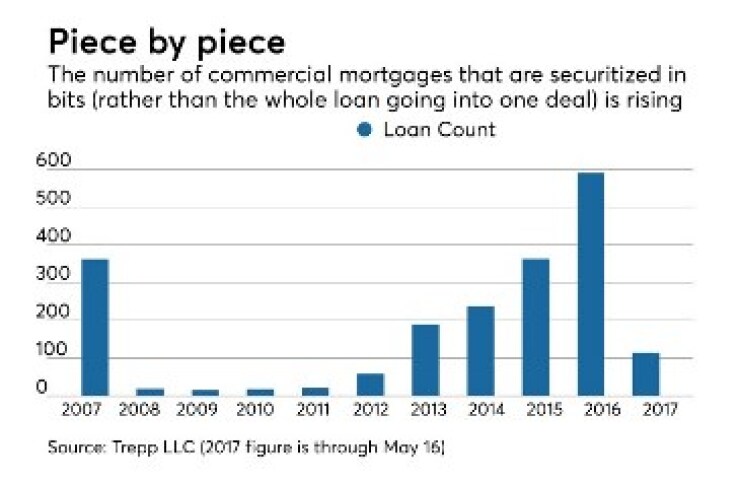

Risk-retention and other regulations under the Dodd-Frank Act have led to subtle but significant changes in the way commercial properties are financed in the securitization market.
Large
But the Dodd-Frank rules increased the cost of funding, resulting in lower overall issuance of commercial mortgage-backed securities, as well as a decline in the average size of CMBS deals backed by multiple loans, known as conduits.
As a result, even some not-so-large loans are increasingly being carved up into smaller, bite-size pieces. Last year, $26 billion of loans tracked by the credit rating agency DBRS were split into close to 500 pieces and bundled into collateral for various mortgage bonds.
“It used to be there was no problem putting a $100 million loan into a conduit,” said Erin Stafford, a managing director at DBRS. “But the average conduit transaction is now around $1 billion,” limiting the size of loans that can be used as collateral without increasing concentration risk of a given pool.
One problem with the trend of pari passu issuance is that when these loans go bad, as some surely will, workouts will inevitably be more complicated than they would be for a whole loan.
In the meantime, pari passu loans have become so endemic that investors putting money to work in more than one CMBS conduit need to pay close attention, lest they end up placing bigger bets than they want.
“When a large loan is spit into so many deals, you can easily end up with too much exposure to that property when you buy tranches of several conduits,” said Teresa Walters, a vice president in portfolio management at Amundi Smith Breeden. “In some recent transactions, more than half of the top 10 loans are pari passu loans.”
The problem is acute for investors buying a lot of CMBS in a short time.
“If there’s a deal with a portion of a large loan, maybe the next five deals are going to have exposure to that loan as well. So you have to be particularly careful,” Walters said. “But if you buy one deal now and then wait a few months to buy another, the likelihood is that the rest of the loan will already have been put into other deals.”
In one example, a $325 million mortgage on the Fresno Fashion Fair Mall, in Fresno, Calif., was split into six notes, ranging in size from $39 million to $80 million, placed in as many conduits between October 2016 and March 2017, according to DBRS. The loan, which the property owner Macerich Co. obtained from JPMorgan Chase and Societe Generale, is backed by 536,093 square feet of the 957,944-square-foot shopping center.
Very large loans, those over $250 million, can still be securitized on their own. Goldman Sachs recently completed two of these transactions, which are known as single-asset, single-borrower CMBS: a $465 million mortgage backed a portfolio of 10 office properties in Houston (in April) and a $350 million mortgage on 485 Lexington Avenue, a 32-story office building in midtown Manhattan (in February).
In some cases, however, lenders are breaking off relatively small pieces of these large loans to be used as collateral in one or more conduits.
In November 2016, a $750 million portion of a $1.275 billion mortgage on the Hilton Hawaiian Village Waikiki Beach Resort, an iconic, 22-acre property on the island of Oahu, was used as collateral for a single-asset CMBS. The five banks that made the loan to Hilton Trust USA have since used smaller portions as collateral in six conduit transactions – so far.
While DBRS does not rate single-asset, single-borrower CMBS, Stafford said breaking off relatively small portions of very large loans may be a way to expand the potential investor base.
“Some investors may not be able to buy single-asset, single-borrower loans,” Stafford said.
Concentration risk isn’t the only potential downside to investing in pari passu loans, however.
Pari passu loans are ultimately controlled by one pooling and servicing agreement and therefore one special servicer. Any loss associated with these loans should theoretically be distributed pro rata among the various pari passu notes contributed to various CMBS transactions. In reality, however, servicers and trustees sometimes apply different loss expenses to different tranches of the same collateral in different CMBS transactions, according to DBRS.
In March, a $2.85 billion loan on a portfolio of 20 office buildings in Seattle and Washington, D.C., owned by Beacon Capital Partners, was disposed from six conduit transactions resulting in losses of over $100 million that were realized across four of the deals, according to a report published by Kroll Bond Rating Agency.
Stafford, the DBRS analyst, said that, in theory, all of the interests in a pari passu structure should be aligned.
“I think where complications come in to play is when there is a lot of subordinate debt” encumbering the property, she said. This financing, which ranks behind securitized loans in payment priority, is subject to intercreditor agreements that can tie up the resolution process.
“Subordinate debtholders interests’ are not aligned, and that’s where there are problems that can cause delays.”




